Simulation Study of Microphysical and Electrical Processes of a Thunderstorm in Sichuan Basin
Abstract
:1. Introduction
2. Materials and Methods
2.1. Data
2.2. The WRF Model
2.3. Microphysical Process
2.4. Non-Inductive Electrification Process
2.5. Lightning Parameterization
3. Atmospheric Circulation Background
4. Analysis of Simulation Results
4.1. Numeral Simulation and Validation
4.2. Microphysical Characteristics Analysis
4.3. Charge Structure
4.4. The Updraft and Downdraft
5. Results and Discussion
- (1)
- The simulation results of the WRF model are correlated with the observed radar reflectivity, lightning characteristics, and the wind field environment in the thunderstorm process, indicating that the WRF model has the ability to reproduce this thunderstorm process in the Sichuan Basin.
- (2)
- The higher content of hydrometeors and stronger convective development in the thunderstorm cell are very favorable to the electrical process of thunderstorms and contribute to the formation of a stable charge structure. Discovered by simulation based on the WRF model, the graupel particles mainly distribute at the height of 8 to 15 km, the shape and distribution height of the number concentration of ice crystals and snow particles is greatly the same, and the distribution height can reach more than 16 km. The core of the electrification area corresponds well with the hydrometeors.
- (3)
- With collisions and separation of ice-phase particles, graupel particles mainly carry negative charges, while ice crystals and snow particles mainly carry positive charges. The charge density of snow particles is generally lower than that of ice crystals and graupel particles. From the perspective of time evolution, each stage of the thunderstorm cell presents a typical dipole charge structure.
- (4)
- Lightning activity is affected by the updraft and downdraft, and the updraft velocity plays a key role in the distribution of ice-phase particles. With the higher velocity of the updraft in a thunderstorm, the discharge is stronger during the collisional and separation of ice-phase particles. There is a certain downdraft under the thunderstorm cell which pulls down a huge amount of charged hydrometeors to form precipitation in the late mature stage of the thunderstorm.
Author Contributions
Funding
Institutional Review Board Statement
Informed Consent Statement
Data Availability Statement
Acknowledgments
Conflicts of Interest
References
- Seity, Y.; Soula, S.; Sauvageot, H. Lightning and precipitation relationship in coastal thunderstorms. J. Geophys. Res. 2001, 106, 22801–22816. [Google Scholar] [CrossRef]
- Price, C.G. Lightning Applications in Weather and Climate Research. Surv. Geophys. 2013, 34, 755–767. [Google Scholar] [CrossRef]
- Zhao, P.; Xiao, H.; Liu, C.; Zhou, Y.; Xu, X.; Hao, K. Evaluating a simple proxy for climatic cloud-to-ground lightning in Sichuan Province with complex terrain, Southwest China. Int. J. Climatol. 2021, 42, 3909–3927. [Google Scholar] [CrossRef]
- Zhao, P.; Xiao, H.; Liu, C.; Zhou, Y. Dependence of Warm Season Cloud-to-Ground Lightning Polarity on Environmental Conditions over Sichuan, Southwest China. Adv. Meteorol. 2021, 2021, 1500470. [Google Scholar] [CrossRef]
- Wu, B.; Verlinde, J.; Sun, J. Dynamical and microphysical retrievals from Doppler radar observations of a deep convective cloud. J. Atmos. Sci. 2000, 57, 262–283. [Google Scholar] [CrossRef]
- Zhang, Y.; Liu, X.; Xiao, Q. An analysis of characteristics of thunderstorm and artificially triggered lightning in the north and south of China. Plateau Meteorol. 1997, 16, 113–121. (In Chinese) [Google Scholar]
- Cui, H.H.; Qie, X.S.; Zhang, Q.L.; Zhang, Y.L.; Zhang, G.S.; Zhao, Y.; Kong, X.Z.; Yuan, T.; Yang, J.; Zhang, T. Equivalent electrical discharge structure of thunderstorm and simultaneous observation of multi-station of cloud flashes in Zhongchuan of Gansu. Plateau Meteorol. 2009, 28, 808–815. (In Chinese) [Google Scholar]
- Zheng, D.; Zhang, Y.; Meng, Q.; Lu, W.; Zhong, M. Lightning activity and electrical structure in a thunderstorm that continued for more than 24 h. Atmos. Res. 2010, 97, 241–256. [Google Scholar] [CrossRef]
- Li, Y.; Zhang, G.; Wen, J.; Wang, D.; Wang, Y.; Zhang, T.; Fan, X.; Wu, B. Electrical structure of a Qinghai–Tibet Plateau thunderstorm based on three-dimensional lightning mapping. Atmos. Res. 2013, 134, 137–149. [Google Scholar] [CrossRef]
- Mason, B.J. The generation of electric charges and fields in thunderstorms. Proc. R. Soc. A Math. Phys. Eng. Sci. 1988, 415, 303–315. [Google Scholar] [CrossRef]
- Rust, W.D.; Marshall, T.C. On abandoning the thunderstorm tripole-charge paradigm. J. Geophys. Res. 1996, 101, 23499–23504. [Google Scholar] [CrossRef]
- Ziegler, C.L.; MacGorman, D.R.; Dye, J.E.; Ray, P.S. A model evaluation of noninductive graupel-ice charging in the early electrification of a mountain thunderstorm. J. Geophys. Res. Atmos. 1991, 96, 12833–12855. [Google Scholar] [CrossRef]
- Zhao, P.; Yin, Y.; Xiao, H. The effects of aerosol on development of thunderstorm electrification: A numerical study. Atmos. Res. 2015, 153, 376–391. [Google Scholar] [CrossRef]
- Tan, Y.; Tao, S.; Liang, Z.; Zhu, B. Numerical study on relationship between lightning types and distribution of space charge and electric potential. J. Geophys. Res. Atmos. 2014, 119, 1003–1014. [Google Scholar] [CrossRef]
- Sun, L.; Qie, X.; Mansell, E.R.; Chen, Z.; Xu, Y.; Jiang, R.; Sun, Z. Feedback effect of electric field force on electrification and charge structure in thunderstorm. Acta Phys. Sin. 2018, 67, 169201. [Google Scholar] [CrossRef]
- Xu, L.; Zhang, Y.; Wang, F.; Zheng, D. Simulation of the electrification of a tropical cyclone using the WRF-ARW model: An idealized case. J. Meteorol. Res. 2014, 28, 453–468. [Google Scholar] [CrossRef]
- Chen, Z.; Qie, X.; Yair, Y.; Liu, D.; Xiao, X.; Wang, D.; Yuan, S. Electrical evolution of a rapidly developing MCS during its vigorous vertical growth phase. Atmos. Res. 2020, 246, 105201. [Google Scholar] [CrossRef]
- Li, P.; Zhai, G.; Pang, W.; Hui, W.; Zhang, W.; Chen, J.; Zhang, L. Preliminary Research on a Comparison and Evaluation of FY-4A LMI and ADTD Data through a Moving Amplification Matching Algorithm. Remote Sens. 2020, 13, 11. [Google Scholar] [CrossRef]
- Liu, Y.; Wang, H.; Li, Z.; Wang, Z. A verification of the lightning detection data from FY-4A LMI as compared with ADTD-2. Atmos. Res. 2021, 248, 105163. [Google Scholar] [CrossRef]
- He, G.; Sun, J.; Ying, Z.; Zhang, L. A Radar Radial Velocity Dealiasing Algorithm for Radar Data Assimilation and Its Evaluation with Observations from Multiple Radar Networks. Remote Sens. 2019, 11, 2457. [Google Scholar] [CrossRef] [Green Version]
- Wu, Z.; Huang, Y.; Zhang, Y.; Zhang, L.; Lei, H.; Zheng, H. Precipitation characteristics of typhoon Lekima (2019) at landfall revealed by joint observations from GPM satellite and S-band radar. Atmos. Res. 2021, 260, 105714. [Google Scholar] [CrossRef]
- Kalnay, E.; Kanamitsu, M.; Kistler, R.; Collins, W.; Deaven, D.; Gandin, L.; Iredell, M.; Saha, S.; White, G.; Woollen, J.; et al. The NMC/NCAR 40-year reanalysis project. Bull. Am. Meteorol. Soc. 1996, 77, 437–471. [Google Scholar] [CrossRef]
- Ren, J.; Xu, Z.; Chen, Q.; Zhang, Q. Climate Characteristics of Thunderstorm in Sichuan in Recent 54 years. Plateau Mt. Meteorol. Res. 2015, 35, 62–67. (In Chinese) [Google Scholar]
- Saunders, C.P.R.; Peck, S.L. Laboratory studies of the influence of the rime accretion rate on charge transfer during crystal/graupel collisions. J. Geophys. Res. 1998, 103, 13949–13956. [Google Scholar] [CrossRef]
- Morrison, H.; Gettelman, A. A New Two-Moment Bulk Stratiform Cloud Microphysics Scheme in the Community Atmosphere Model, Version 3 (CAM3). Part I: Description and Numerical Tests. J. Clim. 2008, 21, 3642–3659. [Google Scholar] [CrossRef]
- Mlawer, E.J.; Taubman, S.J.; Brown, P.D.; Iacono, M.J.; Clough, S.A. Radiative transfer for inhomogeneous atmospheres: RRTM, a validated correlated-k model for the longwave. J. Geophys. Res. 1997, 102, 16663–16682. [Google Scholar] [CrossRef] [Green Version]
- Dudhia, J. Numerical study of Convection Observed during the Winter Monsoon Experiment Using a Mesoscale Two-Dimensional Model. J. Atmos. Sci. 1989, 46, 3077–3107. [Google Scholar] [CrossRef]
- Chen, F.; Mitchell, K.; Schaake, J.; Xue, Y.; Pan, H.L.; Koren, V.; Duan, Q.Y.; Ek, M.; Betts, A. Modeling of land surface evaporation by four schemes and comparison with FIFE observations. J. Geophys. Res. 1996, 101, 7251–7268. [Google Scholar] [CrossRef] [Green Version]
- Hu, X.M.; Nielsen-Gammon, J.W.; Zhang, F. Evaluation of Three Planetary Boundary Layer Schemes in the WRF Model. J. Appl. Meteorol. Climatol. 2010, 49, 1831–1844. [Google Scholar] [CrossRef] [Green Version]
- Kain, J.S.; Fritsch, J.M. A One-Dimensional Entraining/Detraining Plume Model and Its Application in Convective Parameterization. J. Atmos. Sci. 1990, 47, 2784–2802. [Google Scholar] [CrossRef]
- Kain, J.S.; Fritsch, J.M. Convective Parameterization for Mesoscale Models: The Kain-Fritsch Scheme. In The Representation of Cumulus Convection in Numerical Models; Springer: Berlin/Heidelberg, Germany, 1993; pp. 165–170. [Google Scholar] [CrossRef]
- Lin, Y.; Farley, R.D.; Orville, H.D. Bulk Parameterization of the Snow Field in a Cloud Model. J. Clim. Appl. Meteorol. 1983, 22, 1065–1092. [Google Scholar] [CrossRef]
- Mansell, E.R.; MacGorman, D.R.; Ziegler, C.L.; Straka, J.M. Simulated three-dimensional branched lighting in a numerical thunderstorm model. J. Geophys. Res. 2002, 107, 4075. [Google Scholar] [CrossRef] [Green Version]
- Mansell, E.R.; MacGorman, D.R.; Ziegler, C.L.; Straka, J.M. Charge structure and lightning sensitivity in a simulated multicell thunderstorm. J. Geophys. Res. 2005, 110, D12101. [Google Scholar] [CrossRef] [Green Version]
- Rosenfeld, D.; Woodley, W.L. Deep convective clouds with sustained supercooled liquid water down to −37.5 °C. Nature 2000, 405, 440–442. [Google Scholar] [CrossRef]
- Marshall, T.C.; MacCarthy, M.P.; Rust, W.D. Electric field magnitudes and lightning initiation in thunderstorms. J. Geophys. Res. 1995, 100, 7097–7103. [Google Scholar] [CrossRef]
- Kuo, Y.; Cheng, L.; Bao, J. Numerical Simulation of the 1981 Sichuan Flood. Part I: Evolution of a Mesoscale Southwest Vortex. Mon. Weather Rev. 1988, 116, 2481–2504. [Google Scholar] [CrossRef]
- Yu, S.; Gao, W.; Xiao, D.; Peng, J. Observational facts regarding the joint activities of the southwest vortex and plateau vortex after its departure from the Tibetan Plateau. Adv. Atmos. Sci. 2016, 33, 34–46. [Google Scholar] [CrossRef]
- Giovanni, G. Reliability of ERA5 Reanalysis Data for Wind Resource Assessment: A Comparison against Tall Towers. Energies 2021, 14, 4169. [Google Scholar] [CrossRef]
- Zhao, P.; Zhang, Y.; Liu, C.; Zhang, P.; Xiao, H.; Zhou, Y. Potential Relationship Between Aerosols and Positive Cloud-to-Ground Lightning During the Warm Season in Sichuan, Southwest China. Front. Environ. Sci. 2022, 10, 945100. [Google Scholar] [CrossRef]
- Rajeevan, M.; Kesarkar, A.; Thampi, S.B.; Rao, T.N.; Radhakrishna, B.; Rajasekhar, M. Sensitivity of WRF cloud microphysics to simulations of a severe thunderstorm event over Southeast India. Ann. Geophys. 2010, 28, 603–619. [Google Scholar] [CrossRef]
- Lu, J.; Feng, T.; Li, J.; Cai, Z.; Xu, X.; Li, L.; Li, J. Impact of assimilating Himawari-8 derived layered precipitable water with varying cumulus and microphysics parameterization schemes on the simulation of Typhoon Hato. J. Geophys. Res. Atmos. 2019, 124, 3050–3071. [Google Scholar] [CrossRef]
- Williams, E.; Mushtak, V.; Rosenfeld, D.; Goodman, S.; Boccippio, D. Thermodynamic conditions favorable to superlative thunderstorm updraft, mixed phase microphysics and lightning flash rate. Atmos. Res. 2005, 76, 288–306. [Google Scholar] [CrossRef]
- Yang, J.; Zhao, K.; Zheng, Y.; Chen, H.; Chen, G. Microphysical Structure of Thunderstorms and Their Lightning Activity During the mei-yu and Post-mei-yu Periods Over Nanjing, Yangtze River Delta. Geophys. Res. Lett. 2022, 49, e2022GL100952. [Google Scholar] [CrossRef]
- Miller, K.; Gadian, A.; Saunders, C.; Latham, J.; Christian, H. Modelling and observations of thundercloud electrification and lightning. Atmos. Res. 2001, 58, 89–115. [Google Scholar] [CrossRef]
- Wang, C.; Zheng, D.; Zhang, Y.; Liu, L. Relationship between lightning activity and vertical airflow characteristics in thunderstorms. Atmos. Res. 2017, 191, 12–19. [Google Scholar] [CrossRef]
- Wang, F.; Zhang, Y.; Zheng, D. Impact of updraft on neutralized charge rate by lightning in thunderstorms: A simulation case study. J. Meteorol. Res. 2015, 29, 997–1010. [Google Scholar] [CrossRef]
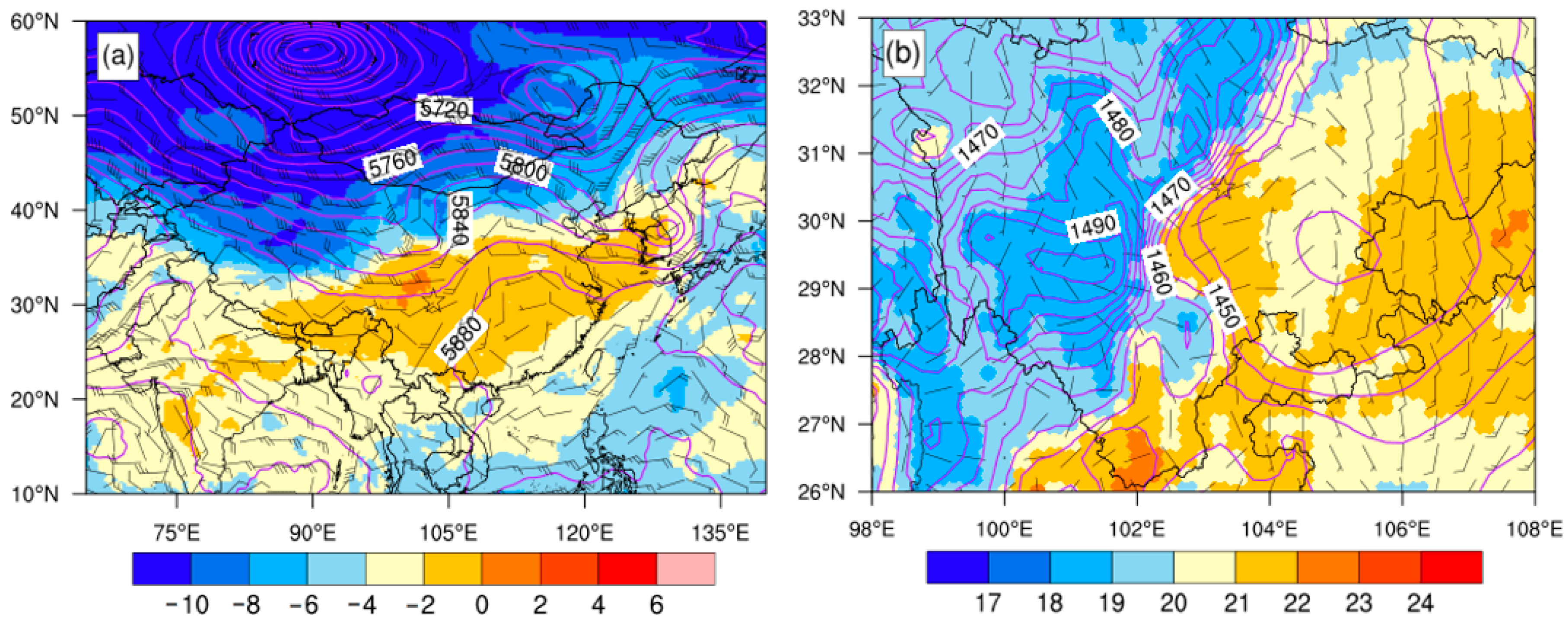


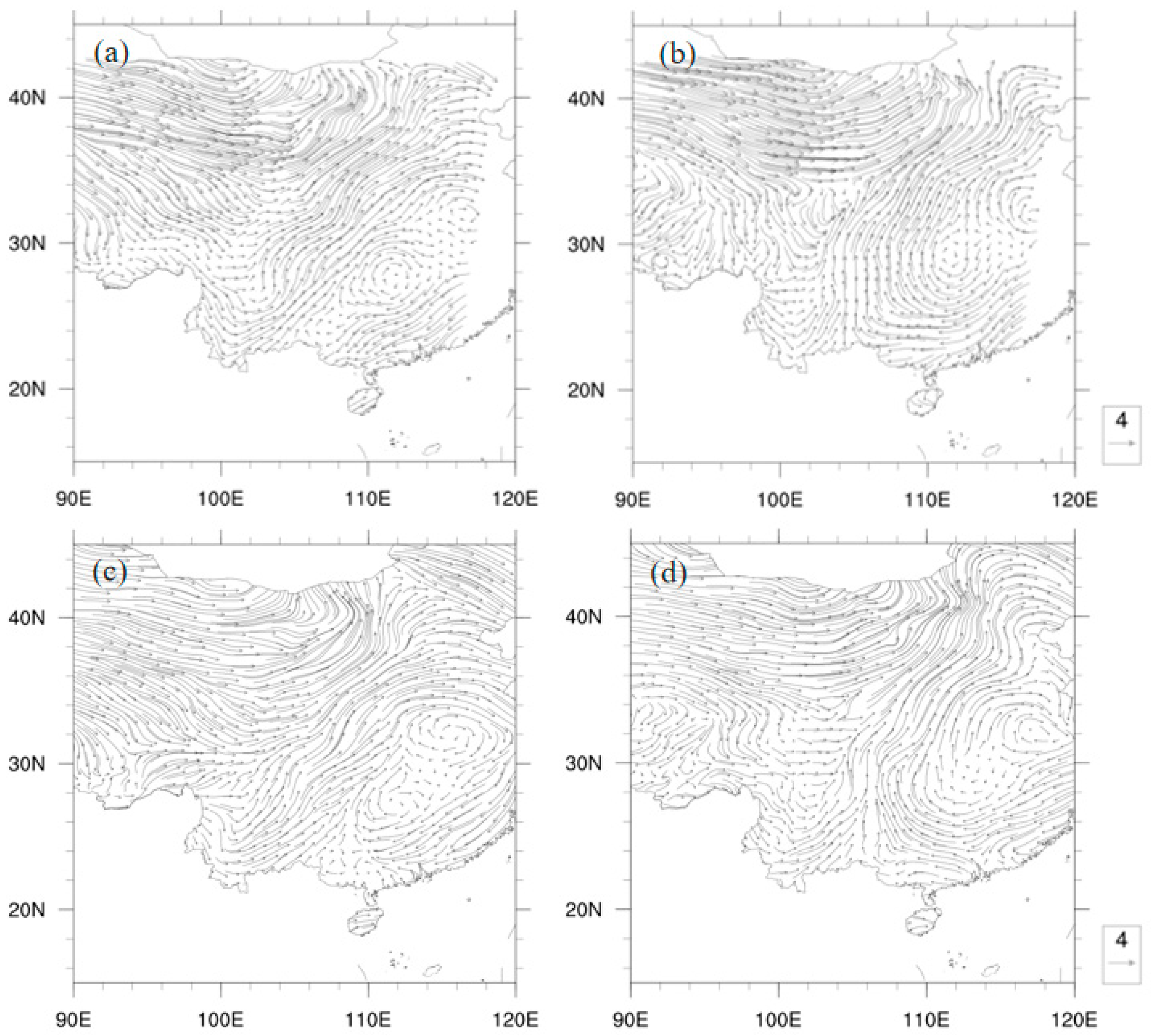
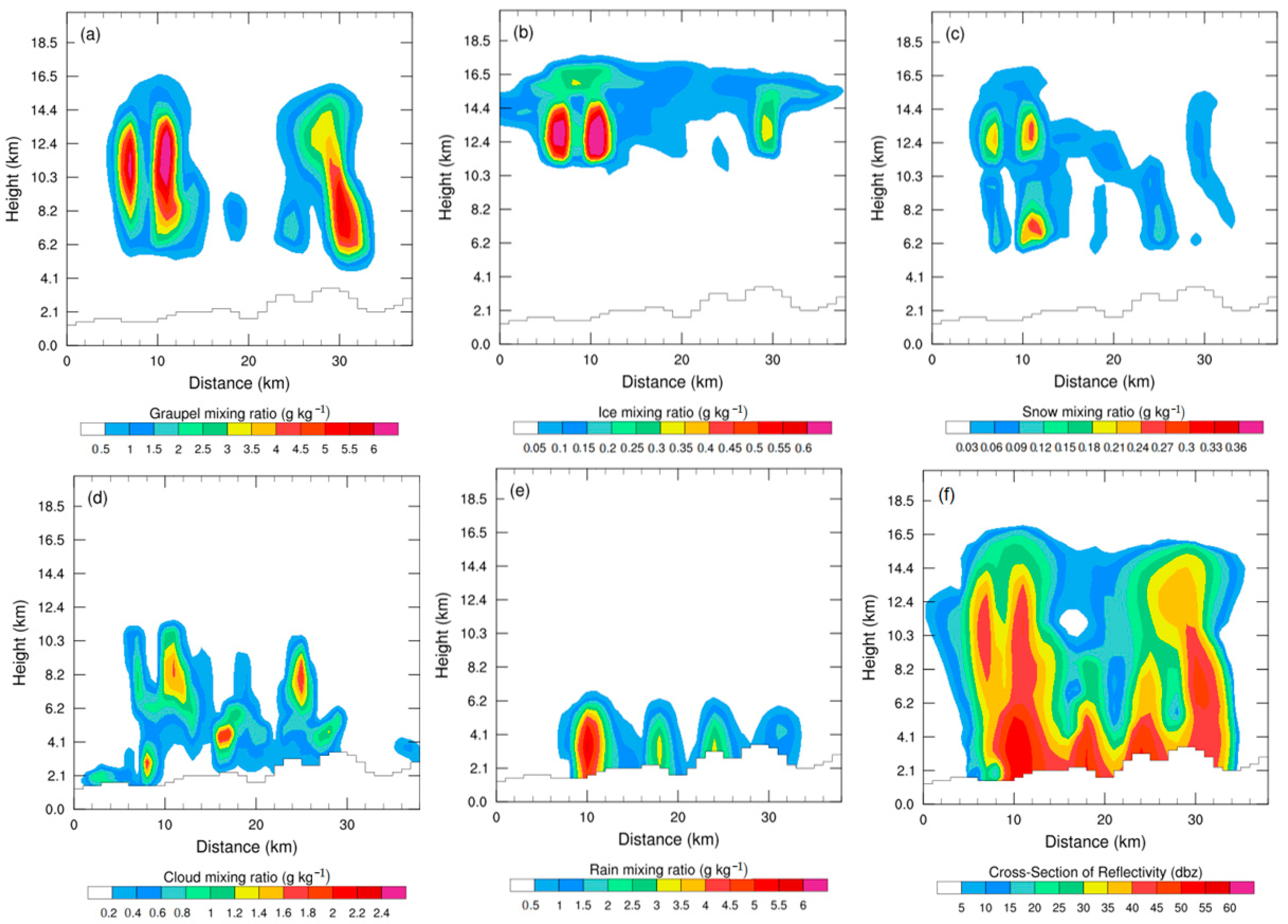
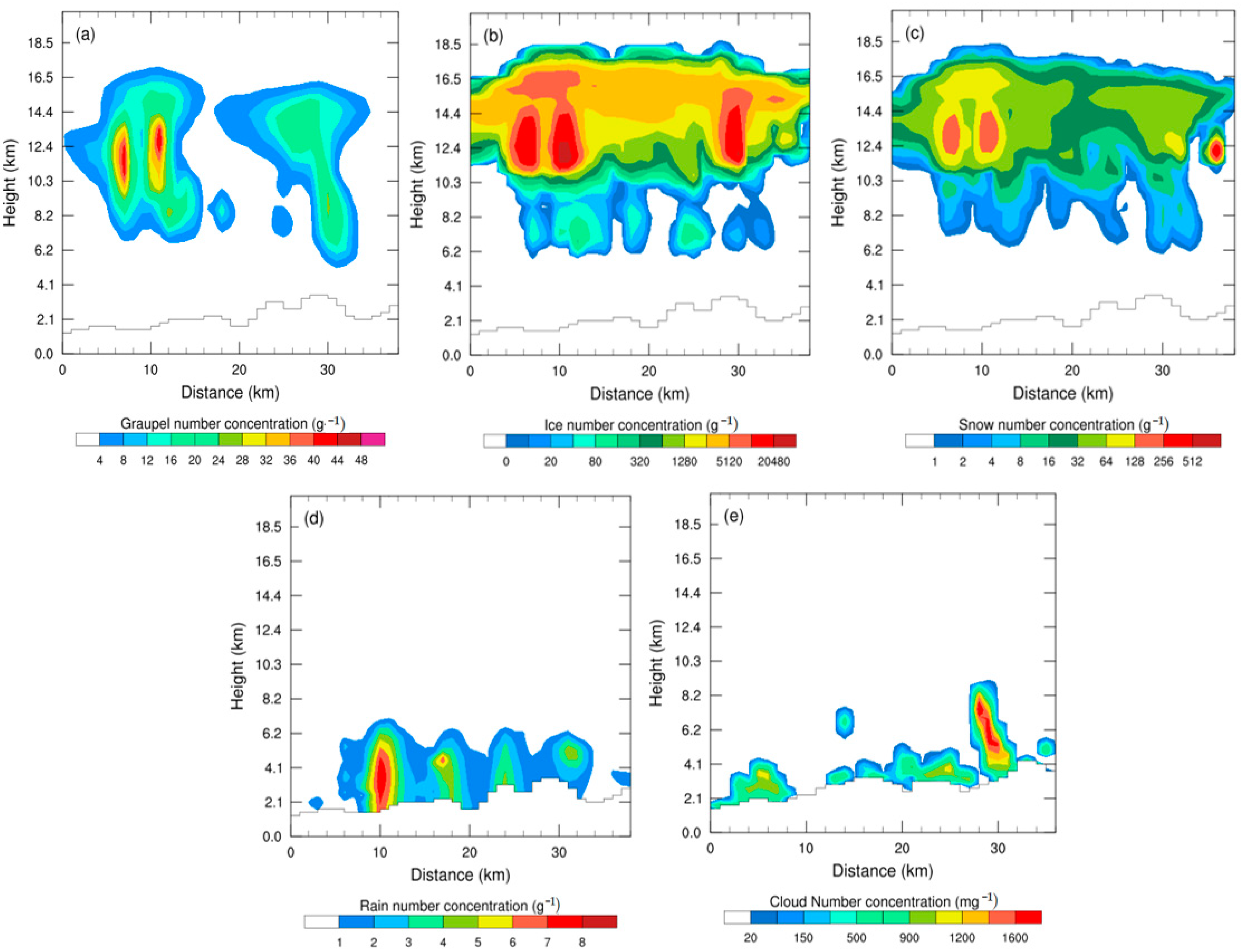

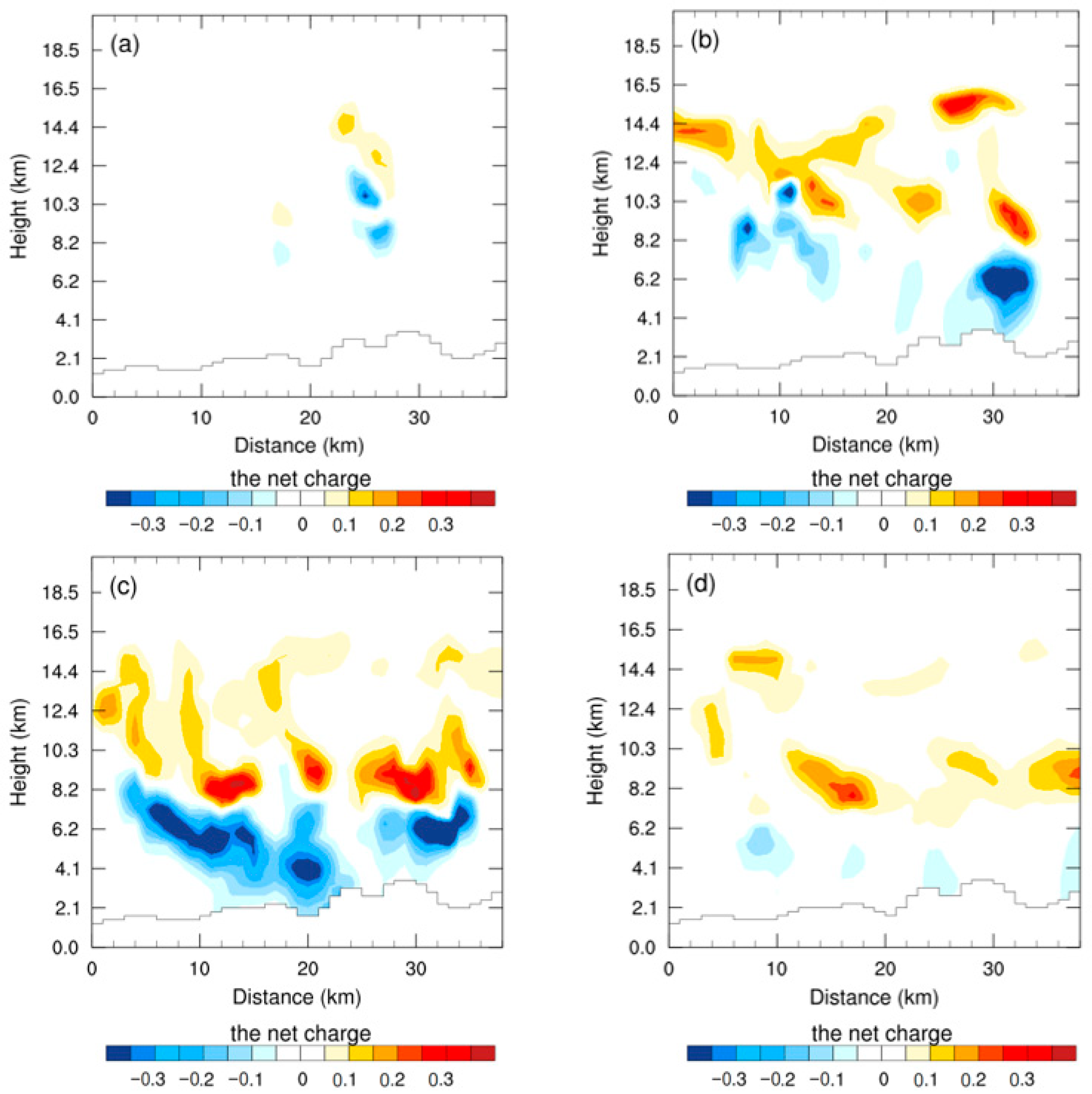
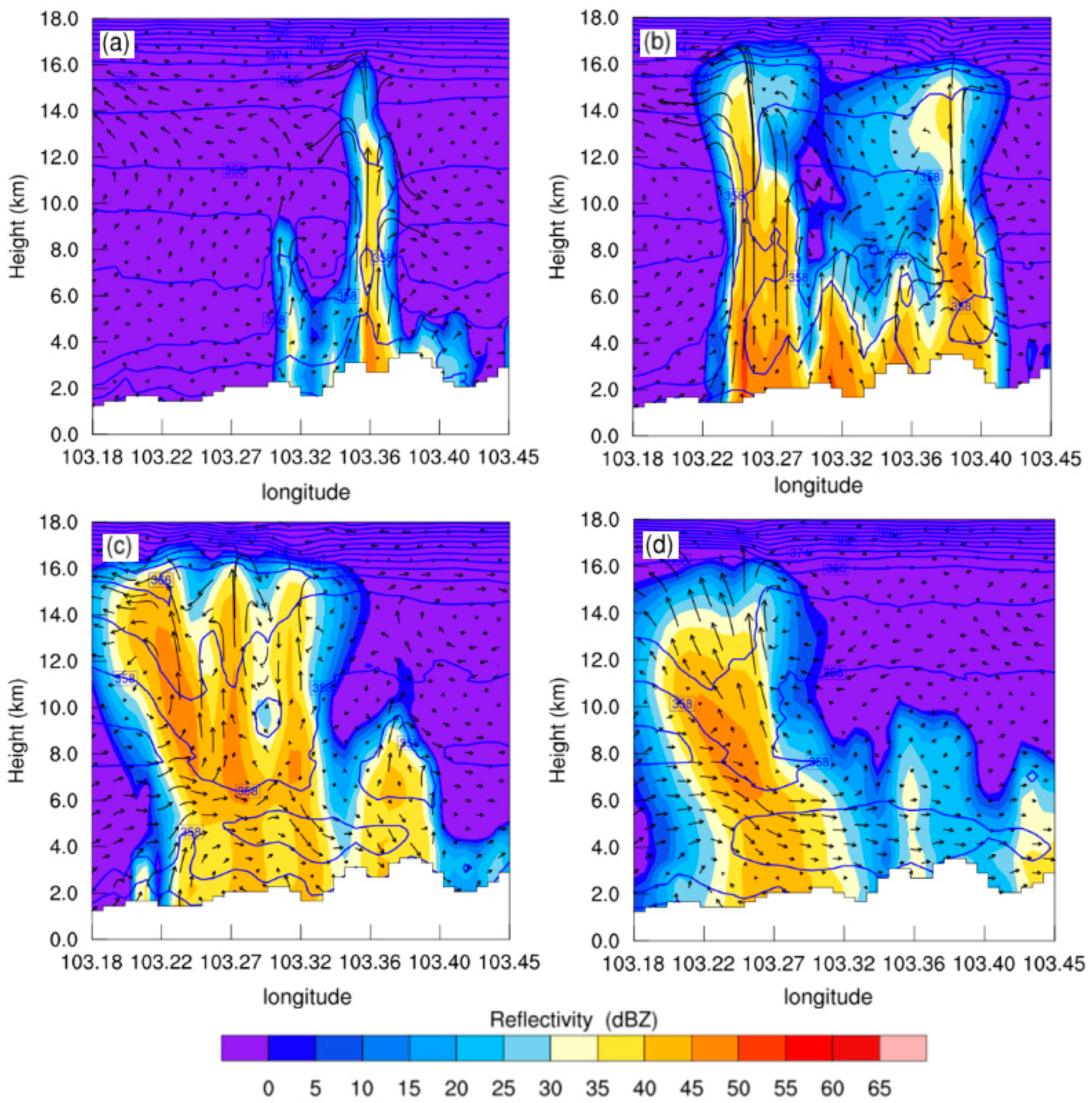
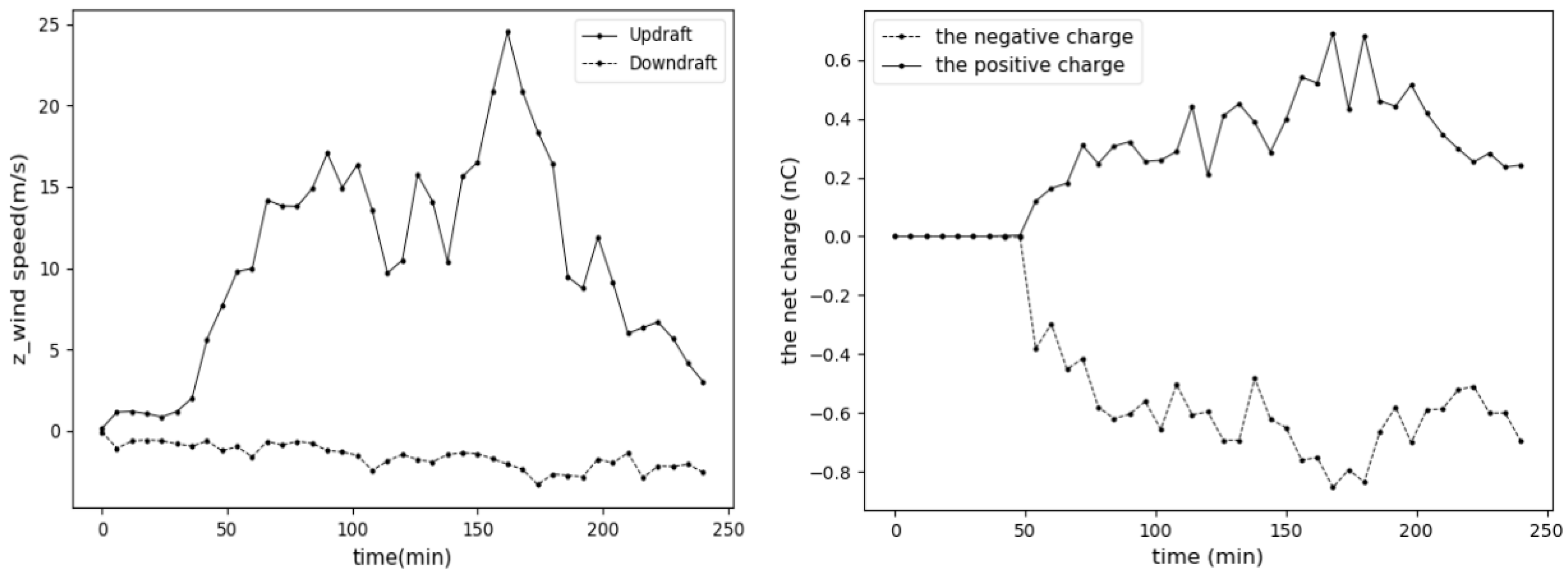
| Polarity | Crystal Size/µm | B | a | b |
|---|---|---|---|---|
| Positive | d < 155 | 4.92 × 1013 | 3.76 | 2.5 |
| Positive | 155 < d < 452 | 4.04 × 106 | 1.9 | 2.5 |
| Positive | d > 452 | 52.8 | 0.44 | 2.5 |
| Negative | d ≤ 253 | 5.24 × 108 | 2.54 | 2.8 |
| Negative | d > 253 | 24.0 | 0.5 | 2.8 |
Disclaimer/Publisher’s Note: The statements, opinions and data contained in all publications are solely those of the individual author(s) and contributor(s) and not of MDPI and/or the editor(s). MDPI and/or the editor(s) disclaim responsibility for any injury to people or property resulting from any ideas, methods, instructions or products referred to in the content. |
© 2023 by the authors. Licensee MDPI, Basel, Switzerland. This article is an open access article distributed under the terms and conditions of the Creative Commons Attribution (CC BY) license (https://creativecommons.org/licenses/by/4.0/).
Share and Cite
Guo, Z.; Zhao, J.; Zhao, P.; He, M.; Yang, Z.; Su, D. Simulation Study of Microphysical and Electrical Processes of a Thunderstorm in Sichuan Basin. Atmosphere 2023, 14, 574. https://doi.org/10.3390/atmos14030574
Guo Z, Zhao J, Zhao P, He M, Yang Z, Su D. Simulation Study of Microphysical and Electrical Processes of a Thunderstorm in Sichuan Basin. Atmosphere. 2023; 14(3):574. https://doi.org/10.3390/atmos14030574
Chicago/Turabian StyleGuo, Zaihua, Jinling Zhao, Pengguo Zhao, Mengyu He, Zhiling Yang, and Debin Su. 2023. "Simulation Study of Microphysical and Electrical Processes of a Thunderstorm in Sichuan Basin" Atmosphere 14, no. 3: 574. https://doi.org/10.3390/atmos14030574




